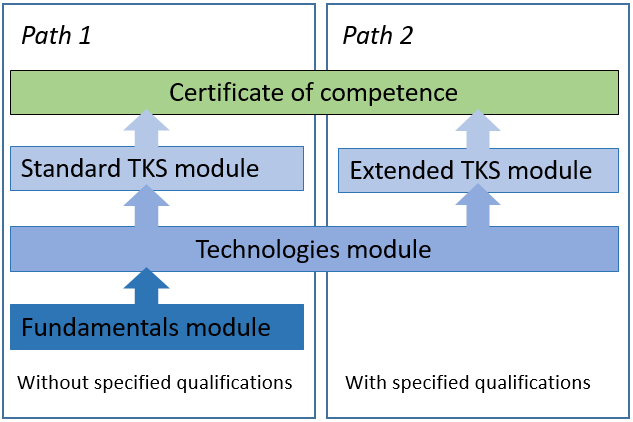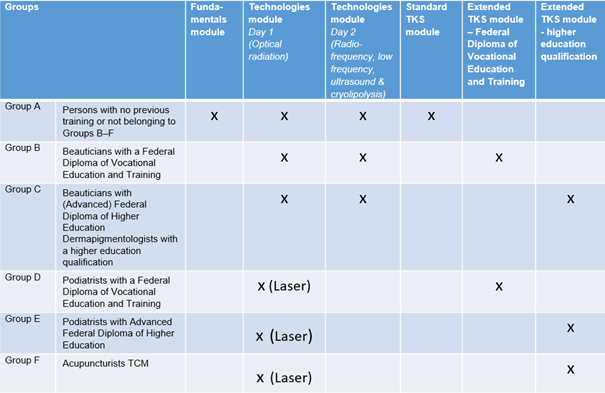What do the training and exam involve? What prerequisites are there?
The certificate of competence comprises three modules – the fundamentals module, the technologies module and one of seven different modules on treatment-specific knowledge and skills (TKS), covering all the treatments for which a certificate of competence is required.
Depending on candidates’ previous training (Table 1), there are two paths for the acquisition of a certificate of competence (Fig.1):
Path 1 is designed for all those who do not have any of the qualifications specified for Path 2. Here, the fundamentals module must first be pursued and successfully completed with an examination. Candidates can then pursue the technologies module and, when this has been successfully completed, the standard TKS module. The certificate of competence is acquired when the examination for the standard TKS module is passed.
Path 2 is designed for beauticians with a Federal Diploma of Vocational Education and Training or an (Advanced) Federal Diploma of Higher Education, dermapigmentologists with a higher education qualification, podiatrists with a Federal Diploma of Vocational Education and Training or an Advanced Federal Diploma of Higher Education, as well as acupuncturists TCM. They are not required to attend the fundamentals module, starting instead with the technologies module. Having successfully completed this module, they are required to pursue an extended TKS module, consisting of the standard TKS module and a shorter version of the fundamentals module. The certificate of competence is acquired when the examination for the extended TKS module is passed.
Depending on the training path and the individual certificate of competence, the duration of training varies between roughly two and eleven days.
Module on fundamentals
The fundamentals module covers the essential knowledge required for the treatments specified in the O-NIRSA, in the following areas: anatomy, physiology and pathophysiology of human skin and hair, changes in skin, vessels, nails and tissue, and assessment of skin, hair, vessels, nails and tissue.
Module on technologies
The technologies module covers essential knowledge of the technologies underlying the treatments specified in the O-NIRSA. The technologies module consists of two parts – Part 1: Optical radiation (laser and IPL), which is compulsory for all candidates; and Part 2: Radiofrequency, low frequency, plasma, ultrasound, shockwaves and cryolipolysis, which is compulsory for all candidates except podiatrists and acupuncturists.
Modules on treatment-specific knowledge and skills (TKS)
Depending on the candidates’ existing qualifications, the TKS module can be offered in a standard or extended form for each certificate of competence.
While the fundamentals and technologies modules are the same for all certificates of competence, the TKS modules cover treatment-specific practical skills and the more detailed technical knowledge required to carry out the treatments specified in the O‑NIRSA. A total of seven modules, covering all treatments, are offered by an examining body.
Standard TKS modules
The standard TKS module is designed for all persons who have no previous training, who do not belong to groups B–D (see Table 1), or who have already acquired a certificate of competence in accordance with the examination regulations of the administrative body. Standard TKS modules are only possible for cosmetic treatments.
Extended TKS modules
Shorter training to acquire the certificate of competence (Path 2, Fig. 1) is available for beauticians with a Federal Diploma of Vocational Education and Training or an (Advanced) Federal Diploma of Higher Education, dermapigmentologists with a higher education qualification, and podiatrists with a Federal Diploma of Vocational Education and Training or an Advanced Federal Diploma of Higher Education, as well as for acupuncturists TCM. In addition to the content of the standard module, this module includes individual sections of the fundamentals module and an overview of the fundamentals module. The persons concerned are not required to attend the fundamentals module, starting instead with the technologies module. Having completed the technologies module, they are required to pursue the extended TKS module.
In addition to the content of the standard TKS module, the extended TKS module includes a shorter version of the fundamentals module. Persons with a Federal Diploma of Vocational Education and Training attend a somewhat longer extended TKS module. In terms of content and duration, the examination is the same for everyone with the same specialisation. The minimum length of training and examinations is specified.
The administrative body and the FOPH recommend that persons who are eligible to pursue the extended modules on the basis of their qualifications (Federal Diploma of Vocational Education and Training or Advanced Federal Diploma of Higher Education) should consult the content of the fundamentals module before starting training and – if they discover gaps in their knowledge – should opt for Path 1 (Fig. 1), attending the complete fundamentals module. With regard to the material on fundamentals, the extended TKS module is designed only to refresh what has already been learned, as well as covering specific fundamentals relating to the new regulations (O-NIRSA).
Last modification 13.10.2023
Contact
Federal Office of Public Health FOPH
Division of Radiological Protection
Non-ionising Radiation and Dosimetry Section
Schwarzenburgstrasse 157
3003
Bern
Switzerland
Tel.
+41 58 462 96 14





